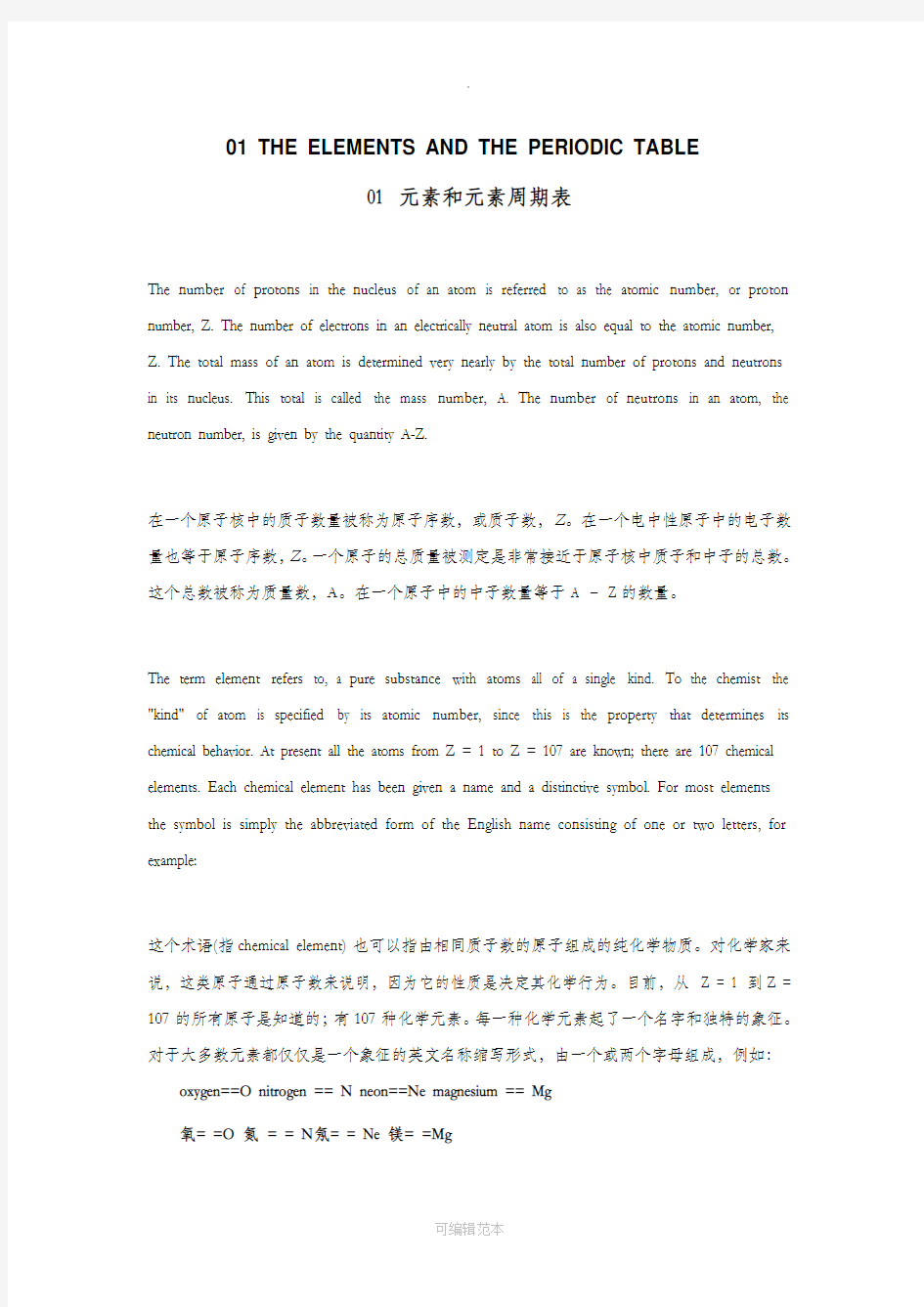化学专业英语(修订版)翻译

- 1、下载文档前请自行甄别文档内容的完整性,平台不提供额外的编辑、内容补充、找答案等附加服务。
- 2、"仅部分预览"的文档,不可在线预览部分如存在完整性等问题,可反馈申请退款(可完整预览的文档不适用该条件!)。
- 3、如文档侵犯您的权益,请联系客服反馈,我们会尽快为您处理(人工客服工作时间:9:00-18:30)。
01 THE ELEMENTS AND THE PERIODIC TABLE
01 元素和元素周期表
The number of protons in the nucleus of an atom is referred to as the atomic number, or proton number, Z. The number of electrons in an electrically neutral atom is also equal to the atomic number, Z. The total mass of an atom is determined very nearly by the total number of protons and neutrons in its nucleus. This total is called the mass number, A. The number of neutrons in an atom, the neutron number, is given by the quantity A-Z.
在一个原子核中的质子数量被称为原子序数,或质子数,Z。在一个电中性原子中的电子数量也等于原子序数,Z。一个原子的总质量被测定是非常接近于原子核中质子和中子的总数。这个总数被称为质量数,A。在一个原子中的中子数量等于A – Z的数量。
The term element refers to, a pure substance with atoms all of a single kind. To the chemist the "kind" of atom is specified by its atomic number, since this is the property that determines its chemical behavior. At present all the atoms from Z = 1 to Z = 107 are known; there are 107 chemical elements. Each chemical element has been given a name and a distinctive symbol. For most elements the symbol is simply the abbreviated form of the English name consisting of one or two letters, for example:
这个术语(指chemical element)也可以指由相同质子数的原子组成的纯化学物质。对化学家来说,这类原子通过原子数来说明,因为它的性质是决定其化学行为。目前,从Z = 1 到Z = 107的所有原子是知道的;有107种化学元素。每一种化学元素起了一个名字和独特的象征。对于大多数元素都仅仅是一个象征的英文名称缩写形式,由一个或两个字母组成,例如:oxygen==O nitrogen == N neon==Ne magnesium == Mg
氧= =O 氮= = N氖= = Ne 镁= =Mg
Some elements,which have been known for a long time,have symbols based on their Latin names, for example:
很久以来就已经知道一些元素,根据他们的拉丁名字符号命名,例如:
iron==Fe(ferrum) copper==Cu(cuprum) lead==Pb(plumbum)
铁= =铁(铁) 铜= =铜(铜) 铅= =铅(铅)
A complete listing of the elements may be found in Table 1.
一个完整的元素可以在表1中被发现。
Beginning in the late seventeenth century with the work of Robert Boyle, who proposed the presently accepted concept of an element, numerous investigations produced a considerable knowledge of the properties of elements and their compounds1. In 1869, D.Mendeleev and L. Meyer, working independently, proposed the periodic law. In modern form, the law states that the properties of the elements are periodic functions of their atomic numbers. In other words, when the elements are listed in order of increasing atomic number, elements having closely similar properties will fall at definite intervals along the list. Thus it is possible to arrange the list of elements in tabular form with elements having similar properties placed in vertical columns2. Such an arrangement is called a periodic.
早在十七世纪末期,罗伯特波义耳就开始了这项工作,他提出了现在公认的元素的概念,大量的研究使我们对元素及其化合物的性质有了相当的了解。在1869年,门捷列夫和迈耶,独立工作,提出了元素周期律。用现代方式,元素周期律阐述了元素的特性原子序数的周期性函数。换句话说,当按原子序数增加的顺序排列元素,具有相近特性的元素将沿着列表以一定的间隔下降。因此,将具有类似性质的元素排成纵列,从而把元素排成表格形式是有可能的。像这样的排列叫元素周期表。
Each horizontal row of elements constitutes a period. It should be noted that the lengths of the periods vary. There is a very short period containing only 2 elements, followed by two short periods
